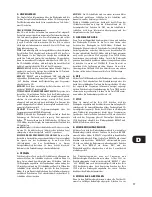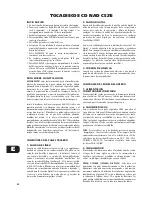
INSTALLING AND REPLACING BATTERIES
The remote control requires two 1.5-volt AAA-size (i.e. UM-4 or
IEC RO3) cells. Alkaline cells are recommended, to obtain
maximum operating life. To open the battery compartment, place
your fingertip in the recess on the rear of the remote control, push
against the flexible edge of the battery cover and lift the cover
upwards. Install fresh cells, orienting them as shown on the
diagram within the compartment.
The coil springs should contact the (-) end of each cell. Push the
battery compartment cover back and press gently until it latches.
In some cases, corrosion or fingerprint oil on the battery contacts
may cause poor operation. Remove both cells, rub the metal
contacts at both ends of each cell with a clean cloth or a pencil
eraser, and re-install the cells, being careful to orient them
correctly.
CD-R & CD-RW AUDIO DISCS
The C521i can play back CD-R & CD-RW audio discs that have
been recorded on a computer or CD-recorder. The quality of
CD-R audio discs varies widely which may affect playability.
Some factors that affect playability:
GB
7
•
•
•
The quality of the disc itself. Generally speaking, CD-R &
CD-RW blanks from well-renowned companies give better
results than unbranded ones.
The quality of CD-recorder or computer CD re/writer. Some
recorders and writers produce better results than others.
The CD-R & CD-RW was created with high-speed writing. In
general, the quality of a CD-R & CD-RW is better when
produced at a lower speed against a higher speed on the same
recorder or re/writer.
The Calender display will indicate remaining track listing. After
completing playback, the C521i will automatically stop, and the
display will again shown all the tracks contained on the inserted
CD.
NOTE:
In the Program-entry mode, the SKIP and
buttons have a “wrap-around” function: if you SKIP Back
repeatedly from Track 01, the number counts down from the final
track on the disc. This provides a convenient way to select high-
numbered tracks.
MAINTENANCE
At periodic intervals, open the disc drawer and wipe with a damp
cloth to remove any loose dust.
lacquer. So a scratch that cuts through the label may damage the
disc more than a similar scratch on the transparent “playing”
surface. Thus you should treat both surfaces of the disc with
care.) Severe scratches or fingerprints may cause the player to
mis-track (skipping ahead, or repeating the same passage). Less
severe damage may produce very brief bursts of high-frequency
noise. The tracking and error-correction circuits of this NAD CD
player are unusually sophisticated, providing secure tracking of
flawed discs that are unplayable on some other players.
Nevertheless, the discs should not be abused or handled
carelessly. For best results, grasp the disc only by its edges.
CLEANING DISCS
Soiled discs may be cleaned by wiping with a soft cloth, either dry
or moistened, with water. Do NOT use conventional LP record-
cleaning products (cleaning solutions, sprays, treated cloths, or
anti-static preparations), nor any kind of chemical solvent
(alcohol, benzene, et al). A severely soiled disc may be washed in
a warm-water spray, possibly with a small amount of a mild kitchen
detergent added, and then wiped dry with a clean, soft towel.
When cleaning the disc, use only RADIAL strokes (from centre to
edge). Never use a circular wiping motion like that used for
cleaning ordinary LP records, because in wiping the disc there is a
risk of scratching it. A radial scratch will do the least harm because
it affects only a small portion of each circular data track, which can
be fully compensated by the player’ s error-correction circuits. But
a circular scratch that follows a data track may damage such a long
continuous segment of data that it cannot be corrected.
ABOUT THE OPTICAL PICKUP
The Compact Disc player uses a solid-state semi-conductor diode
laser, mounted on a tracking servo-mechanism, to play the disc.
The laser illuminates the track of microscopic pits representing
the digital data bits, while photo-diodes detect the reflected
illumination from the disc and convert it into an electronic signal
which is then decoded to recover the musical waveform in each
stereo channel.
You cannot see the laser operating, because it operates at
wavelength of 7800 Angstroms, which is in the infrared and thus
invisible to the human eye.
The Compact Disc player is completely safe for children to use.
The laser operates at very low power and is concealed within the
player mechanism. Even when the player is disassembled, the
laser remains sealed within an optical system that causes its light
to focus only 1 millimeter from the lens and then diverge rapidly,
reducing its intensity to negligible levels.
3.
4.
5.
Repeat Steps 2 to select the track numbers you would like to
delete, up to a maximum of 25 entries but cannot delete
track above track 25.
To play the remaining tracks, just press PLAY. During
playing, the SKIP buttons will access only the tracks still
listed. The deleted songs are not listed.
To clear the memory, press STOP, OPEN/CLOSE to open the
drawer, or switch off the power.
HANDLING COMPACT DISCS
Handle Compact Discs with care. The playback of a disc will not
be impaired by small dust particles, a few light fingerprints, or
slight scratches. But large scratches, or a thick layer of oily
fingerprints, can pre-vent the player from tracking the disc.
(Incidentally, although the tracking optical pickup “plays” the
disc through its clear side, the actual data surface is embedded
directly beneath the label, protected only by a very thin coating of








































